
何世紀にもわたって、東京湾や運河が変わった。
These NHK images show how, over the past several centuries, Tokyo filled in the bay, built canals, and later, in the last satellite image, filled in the canals. (Via Mutant Frog Travelogue).

何世紀にもわたって、東京湾や運河が変わった。
These NHK images show how, over the past several centuries, Tokyo filled in the bay, built canals, and later, in the last satellite image, filled in the canals. (Via Mutant Frog Travelogue).

The Nezu Museum and its gorgeous Japanese garden are a just short walk from the Nishi Azabu Juban wildness, the Kakuremino bar, and lush sidewalk garden. Many people come to the newly rebuilt Nezu Museum for its exquisite collection of pre-modern art, or the new building designed by Kuma Kengo. I am a huge fan of its garden that combines tea houses and paths in a setting that seems ancient, slightly overgrown, bigger than its footprint, and entirely removed from city life.
When I visited recently, just before closing time towards the end of a long, hot summer, I was enchanted by how the light struck this worn boat, the plants growing in its bow, and the illusion of minimal human habitation in an endless jungle. I was also surprised to see Japanese maple leaves already turning red, despite the temperature being above 32 celcius (90 fahrenheit) for many weeks.
Taken together, these four posts about Nishi Azabu Juban speak to the wide range of nature in the city: professional and amateur gardens, single plants and total environments, built and wild, public and gated, destinations and everyday experiences. Plants grow wild even in the densest cities, but how we choose to nurture them provides endlessly varied results. I am inspired by the full range of possibilities.
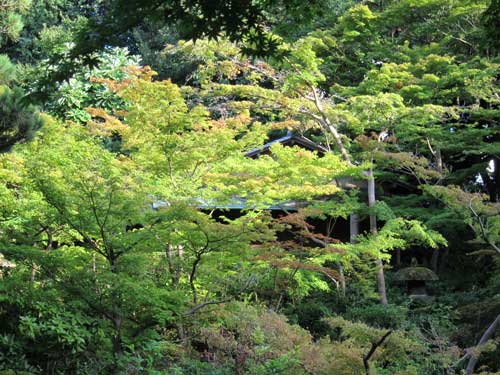
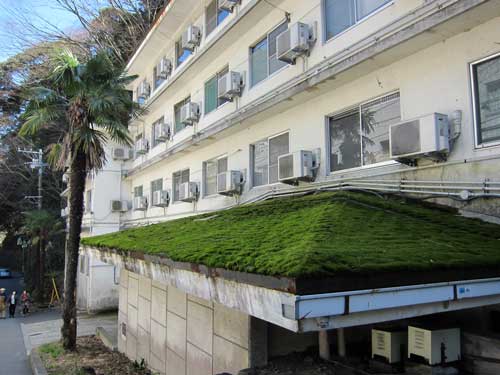
On a Nodai Garden Laboratory trip organized by Hattori sensei, I visited some amazing gardens and shrines, and stayed at a beautiful ryokan called Yoshiike. What I did not expect to see were these incredible moss roofs and walls in unexpected places.
While I love designed gardens, I am also amazed at how nature can impose itself on our built environment, creating beauty in unlikely places. I like the idea of the garden extending itself into the everyday.

Even mundane structures come alive when we let nature colonize our habitat.


This is a close-up of a small tree that has survived the disintegration of its styrofoam planter box and rooted itself into the ground. It is amazing that it was able to force its way through the pavement and reach the soil.
This potted tree breaking the pavement to root itself in the ground is almost the opposite of the cana flower spreading under and breaking the road to reach the air above. I find these images hopeful signs that no matter how much we pave over nature or confine it to a pot, plants are resilient, resourceful and able to confound our built environment.

By rooting itself in the ground below the street, the tree is able to draw more nourishment and grow larger. I wish that governments and residents would begin to de-pave Tokyo, and it’s great to see that domestic plants are not waiting for us to act.

On a beautiful warm November day, I discovered Tokyo University’s Sanshiro-ike garden. I had a few moments before a meeting, and saw on the campus map that there was a central garden on the main campus. I had assumed it would be a formal garden.

I was very surprised to descend a small hillside and encounter this natural looking pond. Looking in all directions, one sees only trees, water and sky, despite the compact size of the garden. Even on a warm weekend day with early fall foliage, few visitors were there. I was enchanted by the incredibly natural and removed-from-the-city feeling in this garden inside central Tokyo and Japan’s most famous university.

It takes a lot of artifice to make a city garden look so natural. The waterfall is amazing.
Continue reading to see some more images from Tokyo University, aka Todai.
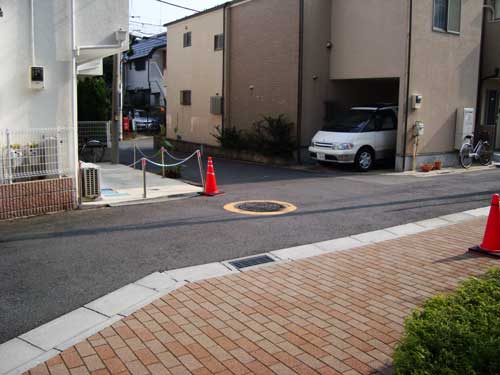
Much of Tokyo is covered in concrete and pavement. In the photo above, a low traffic small street has impermeable pavement. There is a wide, unnecessary brick sidewalk in the foreground built to accompany a recent apartment building. Two private residences also have concrete car-parks and cement surrounds. If you look very closely, to the left of the red traffic cone, a canna flower is breaking through the concrete and blooming.
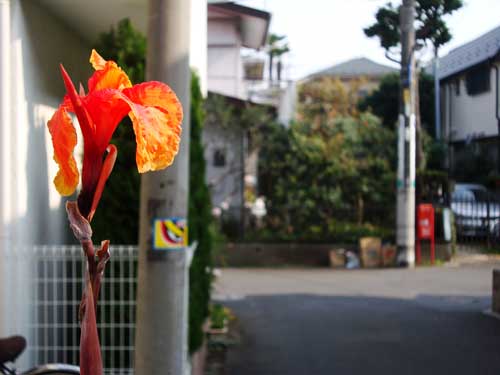
Up close, the flower is brilliant on a sunny November day. Even more remarkable is that the plant has somehow managed to break through the pavement. How did it get there? How does it survive the city’s relentless drive to bury every grain of soil? Do the neighbors appreciate this floral beauty and the power of nature over the built environment?
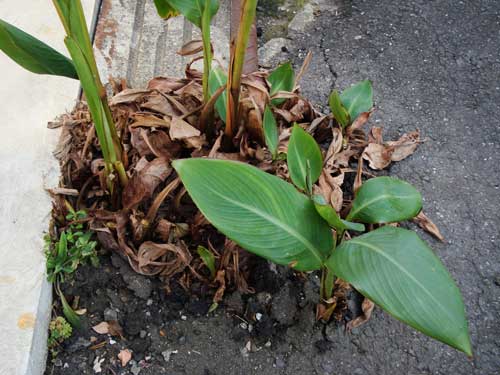
After the jump, a closer view of the plant in its context.